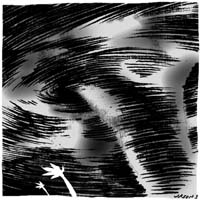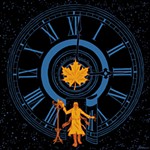Report From L.A.
By Michael Ventura, Fri., Oct. 2, 1998
|
|
Not so, as Mike Davis proves in his catalog of L.A. horrors, Ecology of Fear: Los Angeles and the Imagination of Disaster.Most tornadoes here are reported as "freak winds," but this century has actually seen 75 in the greater Los Angeles area. In fact, there have been 35 since we moved here. "Los Angeles," Davis writes, "is the one great North American metropolis that has suffered from repeated tornado penetrations of its business core." Oklahoma City, usually thought to have the world's worst urban tornado problem, gets one every four years. Downtown L.A., Davis reports, gets hit every 2.2 years.
Granted, the injury rate has been miraculously low; still, why aren't L.A.'s tornadoes common knowledge, at least to its residents? Partly because local news coverage, both print and broadcast, insists on treating each twister as, in Davis' phrase, "nothing short of extraterrestrial." But mostly because of a larger phenomenon that is a major theme of Davis' book: the ability of Angelenos, both individually and institutionally, to retain their image of the city in spite of everything that contradicts and undermines it. Thinking of moving to L.A. to "make it"? Well, as my fellow Texas emigrants can testify, this selective blindness is an infectious disease.
Proof: Davis quotes from the now-defunct Herald Examiner's editorial after one onslaught in 1993: "A series of pyrotechnic thunderstorms? A pair of earthquakes, hours apart? Not one but two tornadoes? In L.A.? In a single day?" Was I out of town? Even if I was, my L.A. friends should have told me about it when I called. Or have we become, God help us, true Angelenos, able to look any disaster in the eye but then instantly forget it the moment it's over?
But this is the least of the questions raised by Mike Davis' Ecology of Fear -- an important book, no matter where you live, if you're interested in the life and fate of your city.
Nobody knows more facts about Los Angeles than Mike Davis, and no one marshals their facts to better effect. He presents his knowledge in clear, efficient prose, and he doesn't kid around. He depicts L.A. as the place where America's social epidemics rage most virulently -- but he's written a lesson-book that other cities need to learn from before they too skid over the edge and find themselves in the same state of helpless free-fall.
Thinking of moving to L.A.? Think again, especially if you have kids. Ecology of Fear begins with Los Angeles' uniquely murderous geology: the most lethal urban earthquake zone in the developed world. Earthquakes are a subject I've studied and written about; I mention this only to emphasize that I learned something new on almost every page of Davis' 50-page chapter on temblors. There's no better layperson's summary in so compact a space. There isn't space to cite his data, but it's worth summarizing his conclusions. Quake activity around L.A. has been mild (compared to its geological history) for nearly 200 years; we are long overdue not just for "the Big One," but for a series of Big Ones, and they almost certainly will occur directly beneath the city or very near it, devastating Southern California on a scale both difficult and terrifying to imagine. Dollar losses could be in the trillions. Loss of life -- casualties could run as high as Hiroshima's.
What significance has this for Austin? Austin sits on the Balcones Fault, which, sooner or later, will probably snap with as much as a six-point quake. A six-pointer is bad in L.A., which has the best building codes in the country; Austin doesn't have such codes. And now we know that even a six-pointer is too much for L.A.'s codes. After Northridge, and Japan's Kobe quake, we also know that the major rivets on high-rise structures snap, and that, in a seven-pointer (some think the Balcones is capable of that), high-rise buildings could literally snap in two -- as some did in Kobe.
But something Davis fails to note in his book is that a major Southern California quake is a problem for everybody, everywhere. Roughly 40% of the U.S. GNP is generated in California. Southern California sits upon fault lines that will, sooner or later, generate massive quakes that will cripple production capacities for a long time. What happens to the American economy if it loses, say, 10-15% of its GNP capacity in less than a minute (the durations of most quakes)? What would that do to America as a world power, not to mention the world's economy (or what's left of it)? A major L.A. quake has the potential to be an event in world history.
And Davis barely touches upon an even larger question: Our technological, economically global civilization requires physical stability -- an unreasonable request to make of the planet. That's just not how Earth behaves. In the United States alone, fault lines and volcanoes riddle the West Coast and the Northwest (the Yellowstone area has as many quakes as L.A.); fault lines run up and down Florida and Manhattan (an island that's recorded two temblors since L.A.'s 1994 Northridge quake). The New Madrid fault in Missouri will sooner or later produce a massive quake on the scale of its1812 event, which some seismologists gauge as more than a nine on the Richter scale -- only now such a quake would destroy the economies of several states (Dallas-Ft. Worth is well into the New Madrid danger zone). They know now that big quakes generate temblors on nearby fault lines, and geologically the Balcones is "near" the New Madrid -- a big quake on the New Madrid could mean a major event for Austin.
There are also fault lines in Nevada, Virginia, Georgia, the Carolinas ... the list goes on. All have been geologically temperamental, and will be again. We have built a civilization that cannot easily adapt to that.
Ecology of Fear's chapters on earthquakes, tornadoes, fires, water, and the flora and fauna of L.A. are fascinating because on every page Davis uses his intimate and intricate knowledge of the city's power politics to show how developers' greed has prevented Los Angeles from becoming the city it might have been. Davis has written a handbook on political infighting useful for any city. He reminds us that justice is handed to no one for free, and must be fought for every year, every season, everywhere. "Politics" is the name of that struggle. And we who shy away from it pay the price, sooner or later, in disaster.
One aspect Davis misses, however, is the quality-of-life impact of the New Age beliefs held by a large segment of the city's white elite -- a feature not quite as prominent in Austin, but growing. Many of those New Age beliefs have contributed to, or have been used to excuse, the white elite's insularity -- for instance, by reducing the complex Hindu-Buddhist concept of "karma" to a simplistic Calvinist-like formula that "people deserve what they get," "people are poor because of behavior in a past life." The insidious half-truth, whether the subject is poverty or cancer, that everyone "makes their own reality," allows many to ignore the complex social, economic, and ecological factors that play upon any individual life. I don't mean that individuals aren't accountable (I'm not interested in the rotten childhood of any rapist or serial killer); I do mean that the collective -- the city, the state, the country -- is also accountable. No one makes it alone; no one fails alone.
(After the 1994 elections gave us the Gingrich Congress, The New York Times reported that people describing themselves as "New Age" voted Republican in higher percentages than people describing themselves as Christian fundamentalists.)
Even the dangers of nature pale beside Ecology of Fear's chapter titled "Beyond Blade Runner," a relentless overview of L.A.'s politics of class and race. Davis calls Southern California "a constitutional no man's land." Reading his data, you must forcefully remind yourself that this is the United States of America, not Indonesia, not China, not Mexico: the working poor ruthlessly taxed to provide amenities for the affluent; the monstrous growth of the prison lobby's power, as in Texas; the tolerance of white hate-groups as an official policy meant to obstruct and oppress people of color; the pervasive use of police surveillance; a privatization of "law enforcement" that often amounts to officially sanctioned vigilantism -- one sickening symptom of constitutional decay after another. Davis strips the gilt off L.A. and shows what it means, in terms of raw suffering, to structure a polity to benefit the affluent, with no other value governing political and economic decisions. And for that, every citizen is accountable. Geologically and politically, we have built our cities on dangerous ground.
A version of this piece appeared in In These Times.









